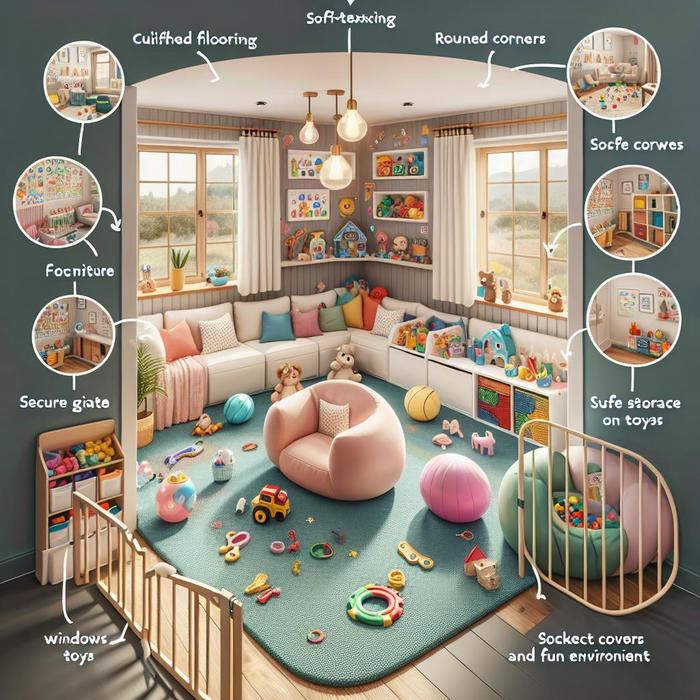Starting with the Basics: Child-Proofing the Playroom
Embarking on the journey of creating the perfect playroom for your child can be both exciting and challenging. To build a safe playroom, essential tips include child-proofing the space and preventing accidents. These crucial steps will ensure not just a fun environment but a safe haven that promotes learning and growth.
Child-Proofing Essentials
Making a room childproof revolves around eliminating risks that could potentially harm your toddler. Here’s a comprehensive list of things you should consider:
- Anchoring heavy furniture to the wall to prevent it from tipping over.
- Installing soft corner protectors on sharp furniture edges.
- Securing blind and curtain cords out of your child’s reach.
- Using childproof locks on cabinets and drawers.
- Covering electrical outlets with safety caps.
Appropriate child-proofing is the foundation of your playroom, and by implementing these precautions, you will be significantly reducing the risk of accidents.
Creating a Safe Play Environment
Making a playroom safe goes beyond child-proofing. Careful attention should be given to the toys and materials you choose, as they will significantly influence the safety of the room. You can consider:
- Using non-toxic, washable paints and materials.
- Opting for age-appropriate toys that are free from choking hazards.
- Ensuring ample lighting for visibility.
- Designing a clutter-free space to avoid trip hazards.
- Positioning furniture and toys away from windows.
By paying attention to these aspects, you can significantly reduce potential dangers and provide a nurturing environment for your child. For more insights on mimicking the natural feeding behaviors in a safe environment, consider visiting this informative guide.
Strength in Support: External Resources for a Safe Playroom
There are numerous resources available online that provide guidelines and tips for creating safe play environments. Websites such as the Office of Children and Family Services and Virtual Lab School offer strategies for playground safety that can be adapted to indoor playrooms.
For those DIY enthusiasts, websites like KidEcology provide creative solutions for child-safe play areas. They offer a multitude of ideas that prioritise safety while stimulating your child’s senses and cognitive development.
To gain insights from other parents and educators, sites like Quora serve as platforms for sharing personal experiences and seeking advice from a diverse community.
As we continue on this topic, we’ll delve deeper into creating stimulating and enjoyable spaces for your little ones.
Understanding and Implementing Safety Standards
Safety standards should not be overlooked when designing your child’s playroom. The American Society for Testing and Materials (ASTM) provides a set of playground safety standards that can ideally be extended to a children’s playroom. You can get a better understanding of these guidelines by visiting the Playground Guardian page. Their guide offers a detailed perspective on ASTM playground safety standards and their importance.
By following these standards, parents can create a safer and more fun-filled play environment for their toddlers. Differential standards for swings, climbing equipment, and guardrails ensure that each aspect of the playroom is thoroughly evaluated and maintained according to international safety regulations.
Structuring the Playroom
When structuring your child’s playroom, however, just considering safety isn’t enough. The room should also be fun and functional, offering variety without haphazard chaos. Here’s what you can do:
- Create designated zones for various activities – reading, arts and crafts, and action figures etc.
- Include sensory-enhancing toys and ample open space for physical activities.
- Use vibrant colours and kids’ artworks to decorate the room.
- Ensure comfort with cozy seating options and soft carpeting.
- Remember to include accessible storage for easier clean-up.
These steps help create a balanced environment where your child can learn while enjoying and exploring.
Choosing the Right Toys and Equipment
When it comes to toys and equipment, safety and relevance should drive your decision-making process. Along with looking for the CE (Conformité Européene) mark and following the age recommendations on the toys, you should also ensure that they facilitate learning and development. A healthy mix of imaginative toys, puzzles, musical instruments, and motor skill-enhancing toys can contribute substantially to your child’s intellectual growth.
Supervision and the Role of Caretakers
Despite all precautions and safety measures, supervision remains a crucial aspect of ensuring a safe play environment. Active involvement and responsible supervision can prevent most of the accidents and ensure a conducive environment for play and learning. My Loss Control Services provides a detailed guide on supervisory roles and their responsibilities. Caretakers should ensure a physical presence, stay alert and attentive, and encourage safe play.
The Learning Curve
Lastly, as your child grows, their needs change. The playroom should grow with them – transitioning from a toddler playroom to a safe room for a preschooler. It should be a continuous process of eliminating hazards and replacing obsolete toys with age-appropriate, stimulating ones. Here, resources such as the Maryland’s Playground Safety guide can provide valuable inputs for age-appropriate safety measures.
By paying attention to these aspects and progressively adapting the space, you can ensure the playroom remains a stimulating, safe haven for your child throughout their development stages.
In the next series, we will explore how to design the perfect playroom for children with special needs, focusing on accessibility and inclusivity. Till then, happy parenting!

